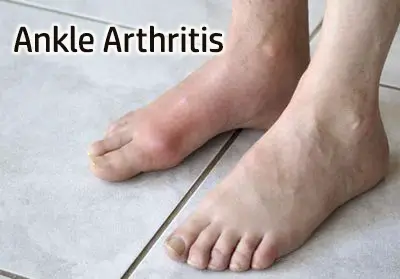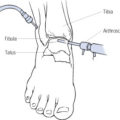*This page may contain affiliate links. When you buy through these links, we may earn a small commission at no extra cost to you.
Arthritis is basically an inflammation of the joints (one or more) in our body.
While it may occur in any of the body joints, it’s more common in smaller joints like the foot and ankle.
There can be many types of foot and ankle arthritis. Depending on the condition’s severity it may affect your lifestyle significantly.
Although no permanent cures or treatments are available to combat the problem, you can improve your condition by following certain tips and treatment methods.
These can actually help deal with the ankle/foot arthritis problem by slowing down the progress of the disease and thereby relieving the symptoms.
Before we detail the best ankle arthritis treatment methods, let us first try to understand its causes, symptoms, and types.
Ankle Arthritis Causes and Types
The ankle joint is formed with the help of two different bones.
One is in the shin area or the shaft of the leg, called the tibia, and the others are in the ankle region called the talus.
These two bones together form the tibiotalar joint.

Inflammation caused in these ankle joints leads to a chronic ankle arthritis condition, which most of the time cannot be treated permanently.
Depending on the three major types of arthritis, there can be various causes of developing ankle and foot arthritis.
These 3 types of ankle arthritis are:
- Posttraumatic arthritis,
- Rheumatoid arthritis, and
- Osteoarthritis
1- Post-Traumatic Arthritis
Injury of the bones present in the ankle joint is one of the main causes of inflammation of the joint.
If not treated properly initially, this may lead to ankle arthritis or “post-traumatic arthritis” over time.
Even in cases where the injury of the ankle joint is treated well, there are high chances of the ankle getting arthritis as compared to the uninjured ankle joint. This may happen years after the injury gets healed.
Some of the major injuries which can develop into an arthritic ankle are ankle joint fracture, ankle joint cartilage damage, torn ligament, etc.
2- Rheumatoid Arthritis
Rheumatoid arthritis, which is an autoimmune disease, that particularly affects your ankle and foot region is called rheumatoid ankle arthritis.
While rheumatoid arthritis may affect a range of different joints in the body, it usually starts with the foot and ankle.
It is usually an asymmetrical disease and thus affects the same joints of the foot on both sides of the body.
Although the exact cause of rheumatoid ankle arthritis is not known, it is believed that the problem usually gets triggered due to some external environmental factors that cause the infection.
When exposed to these triggers, the weaker immune system produces the substance which attacks the joints and causes ankle arthritis.
3- Osteoarthritis
Ankle osteoarthritis (also known as degenerative or wear-and-tear arthritis) is basically a problem that is more common in aged people.
However, due to the detrimental lifestyles of today’s generation, this may develop in younger people too.
Besides age and lifestyle, other risk factors for foot osteoarthritis include obesity and family history.
In osteoarthritis of the ankle, the cartilage present in the ankle joints wears away gradually, getting rougher and frayed.
In the process, the protective space between the bones decreases, resulting in greater bone rubbing and painful bone spurs.
Ankle and foot osteoarthritis generally worsens over time, causing more pain and stiffness in the joints.
It is therefore important to lead a healthy lifestyle and to get the possible treatment as soon as possible.
Ankle Arthritis Symptoms and Signs
People having arthritis in the foot or ankle do experience one or more of the following arthritis in feet symptoms:
- Swelling in or around joint
- Pain, stiffness & tenderness in joint
- Difficulty in walking or in bending joint
- Increased pain and swelling while moving or performing activities
- Increased pain and swelling after sitting for a few hours or in the morning
The less common symptoms like numbness in the sole and toes, tingling sensation in the feet, irritation in the sole, etc., are also felt in certain cases.
Some patients who suffer from foot arthritis may also develop bone spur or a bony protrusion at an affected joint area.
The shoe pressure may result in pain at the site of the bone spur, and in a few cases, calluses or blisters may form above its surface.
This bone spurs also limit the movement of the joint in many.
Best Ankle Arthritis Treatment And Home Remedies
For helping in relieving the symptoms of arthritis foot/ankle, your doctor may recommend some of the non-surgical treatment methods as below:
1- Lifestyle changes:
Making a few lifestyle changes and leading a healthy lifestyle is one of the most helpful ways by which you can lower the pain caused due to ankle and foot arthritis.
To make these changes, you should start by following a regular exercising routine.
Care that you do not indulge in high-impact activities like jogging. Rather you should focus on walking and cycling.
If you are suffering from overweight or obesity conditions, you are most likely to suffer from the symptoms of ankle arthritis.
You should, therefore, work on reducing your weight so that you can eventually reduce the stress caused by the ankle joints.
In addition to these, you should try to consume a well-balanced diet along with proper rest and sleep.
2- Braces and orthotic devices:
Ankle brace for arthritis in the foot helps restrict the motion and to support the joints.
This also helps in reducing the pain during walking and to prevent further deformity.
Immobilization by wearing an ankle cast boot is also a great way to reduce the inflammation caused due to severe ankle arthritis.
Custom-made orthotic devices or shoe inserts are often prescribed for individuals suffering from arthritic foot and ankle.
These help in reducing pain by providing proper support to your foot.
3- Physical therapy and massage:
Trying physical therapy is one of the best home remedies for arthritis in the feet and ankle.
It not only helps to strengthen muscles but also provides greater flexibility and increased range of motion for an arthritis foot.
You should get in touch with your physical therapist to know about these customized sets of exercises according to your needs and lifestyle.
Massaging sessions like foot reflexology in the spa or at home can also do wonders for your pain.
Not only does it relax painful arthritic ankle joints, but also it rejuvenates your body completely for increased energy.
4- Posture and footwear:
Studies show that balancing the whole body by standing on both legs equally (while working) can help in reducing the painful symptoms of arthritis to a great extent.
Changing your body posture while standing and gait modifications can help relieve ankle arthritis pain in many patients.
For many of the patients, doctors also suggest changing their footwear to ones that are specially designed for arthritic patients.
Just simply changing the footwear can helps in relieving the problem gradually.
5- Medications:
While nonsteroidal anti-inflammatory drugs or NSAIDs like ibuprofen can be used in lessening the arthritis pain and inflammation in the foot, steroid injections and medications may also be needed in some cases for getting faster relief from pain.
Although these medications are effective in providing faster relief, the results are most of the time temporary.
6- Herbs and Supplements:
Supplements for arthritis in the feet are most of the time recommended for people who want to try alternate home remedies.
These can prove helpful for relieving the painful condition of foot arthritis slowly and steadily.
Some of the best-recommended supplements & herbs for ankle arthritis include Glucosamine, SAM-e, Omega-3 Fatty Acids, Vitamin C, Willow Bark, Devil’s Claw, Black Pepper, Garlic, Ginger, Turmeric, and Cinnamon.
Surgery for Ankle Arthritis: When Do You Need?
When the osteoarthritis of the ankle has progressed substantially to cause disability OR it fails to improve with non-surgical treatment options, getting surgical treatment for pain relief is often recommended by the doctors.
The type of surgery you can get mostly depends on the severity of arthritis, its location, and its type.
Your doctor can recommend more than one type of surgery based on your health condition. These are:
- Arthroscopic debridement
- Arthrodesis (fusion)
- Total ankle replacement (arthroplasty)
At times there may also be some risks involved, especially when the surgery was not performed properly. A few of the risks involved in ankle surgery are:
- Damage to blood vessel or nerve
- Weakness, instability, and stiffness in the ankle
- Breakage of bone
- Allergic reaction to artificial joint
- Skin not healing after the surgery
- Loosening of artificial joint over the period of time
- Dislocation of the artificial joint after some time
What To Do Before and After The Surgery?
Before undergoing ankle surgery, you must tell your doctor in advance about drugs, herbs, and supplements you have been taking with or without a prescription for treating your ankle.
Before two weeks of surgery, take care of the following things:
- You should stop taking medicines like naproxen, aspirin, and ibuprofen to avoid the chances of blood clotting during and after surgery.
- Stop smoking as it slows down the process of wound and bone healing.
- If you are diabetic or suffering from any heart ailment, it would be required for you to get these conditions checked by a doctor before undergoing surgery.
- Ask the doctor about which drugs to take during the surgery.
- If you take more than two glasses of alcohol in a day, make sure you disclose it to your surgeon beforehand.
- Tell your surgeon if you are suffering from a cold, herpes breakout, flu, or fever before your surgery.
On the day of your ankle surgery, you would be asked not to eat anything 6-12 hours prior to your surgery.
Also, the doctor may suggest you take some drugs with a sip of water.
After ankle replacement surgery, you may be required to stay in the hospital for 4-5 days as your ankle will be bandaged.
To reduce swelling, you may have to keep your foot raised higher than your heart while sleeping or resting.
In most cases, getting surgical treatment for ankle arthritis helps in relieving the condition, helping to perform your daily tasks easier.
However, the time of getting complete recovery may vary for patients (from 3 to 9 months) depending on their condition.
Incoming search terms:- ankle arthritis symptoms
- arthritis in ankles symptoms
- ankle arthritis






